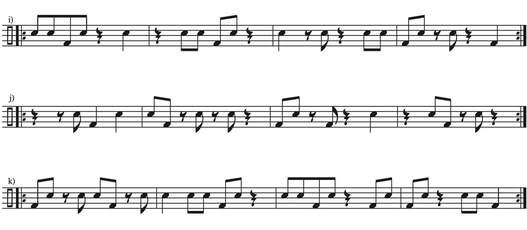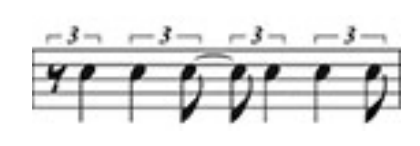Audio 7: page 94 (lines ijk)
Track: Blue Train/John Coltrane/Blue Train/1958
Track info: Tenor sax solo/:38-1:16
Personnel: John Coltrane, tenor saxophone; Lee Morgan, trumpet; Curtis Fuller, trombone:
Kenny Drew, piano; Paul Chambers, bass; Philly Joe Jones, drums
Tempo: quarter = 138-144 bpm
Notes on book use:
I chose to use just the first two choruses of Coltrane's solo to record some of the patterns from page 94 (first 3 lines - ijk). I wanted to illustrate the sound of the patterns with more active comping in the rhythm section, especially coming from the piano and drums. I maintained the standard ride cymbal pattern (#3 in ride cymbal ostinatos on p. 81).
Philly Joe Jones plays some interesting triplet patterns on this track that I cover in detail in Drumset Concepts Volume II - Advanced Jazz Comping in the Swing Style. One that he uses frequently is the quarter-note triplet that starts on the upbeat, giving it a feeling of displacement:
Track: Blue Train/John Coltrane/Blue Train/1958
Track info: Tenor sax solo/:38-1:16
Personnel: John Coltrane, tenor saxophone; Lee Morgan, trumpet; Curtis Fuller, trombone:
Kenny Drew, piano; Paul Chambers, bass; Philly Joe Jones, drums
Tempo: quarter = 138-144 bpm
Notes on book use:
I chose to use just the first two choruses of Coltrane's solo to record some of the patterns from page 94 (first 3 lines - ijk). I wanted to illustrate the sound of the patterns with more active comping in the rhythm section, especially coming from the piano and drums. I maintained the standard ride cymbal pattern (#3 in ride cymbal ostinatos on p. 81).
Philly Joe Jones plays some interesting triplet patterns on this track that I cover in detail in Drumset Concepts Volume II - Advanced Jazz Comping in the Swing Style. One that he uses frequently is the quarter-note triplet that starts on the upbeat, giving it a feeling of displacement:
You can hear portions of this idea at 2:23, 2:43, 3:13, 3:17 and many other spots in the track.
In playing through this whole track, the double-time feel coming from the drums is of particular interest. Each of the soloists play over this double-time treatment, while the walking quarter-note bass line continues uninterrupted. This tug of tension and release is one of the things that make this track so unique and fun to play along with.
Notes on performance:
Form: 12-bar blues
This classic blues head is played twice at the top with the melody being harmonized the second time. Coltrane takes the first solo, which covers eight choruses and lasts from :38-3:22. Philly Joe Jones' comping features a number of snare drum offbeats and triplet figures (see triplet notation above) which often set up-beat '2' or beat '4' on the bass drum. Later in Coltrane's solo, he implies double-time in the hi-hat, while maintaining the hands primarily in the regular time feel - undoubtedly reacting to the almost continuous double-time lines coming from Coltrane. This can be heard during the fourth and fifth chorus (1:36-2:18). When the background lines come in during the sixth and seventh choruses, he moves the hi-hat back to beats '2' and '4' (2:18-3:00). The final Coltrane chorus finishes at 3:22 with a flourish in the drums.
The trumpet solo from Lee Morgan covers five choruses (3:22-5:10), and Philly Joe adds his signature double-time feel to the third and fourth choruses of this solo (4:05-4:48), again matching the double-time feel coming from the trumpet.
Curtis Fuller's trombone solo (5:10-7:00) follows a similar script, covering five choruses, with the same double-time input from the drums in the third and fourth choruses. The piano solo encompasses six choruses, (double-time in fourth and fifth choruses). Finally, the bass solos over two choruses, and then the head gets played out twice to the end.
Listening to the consistency of the double-time interjections, one would suspect this may have been a pre-determined idea for the record date - or certainly an idea that the group liked to use. The thing that makes this track unique is that at no time does the bass vary from the quarter-note, making for an interesting juxtaposition of time ideas. Some of the double-time choruses are even signaled in the drums 3 or 4 bars before the chorus begins.
In playing through this whole track, the double-time feel coming from the drums is of particular interest. Each of the soloists play over this double-time treatment, while the walking quarter-note bass line continues uninterrupted. This tug of tension and release is one of the things that make this track so unique and fun to play along with.
Notes on performance:
Form: 12-bar blues
This classic blues head is played twice at the top with the melody being harmonized the second time. Coltrane takes the first solo, which covers eight choruses and lasts from :38-3:22. Philly Joe Jones' comping features a number of snare drum offbeats and triplet figures (see triplet notation above) which often set up-beat '2' or beat '4' on the bass drum. Later in Coltrane's solo, he implies double-time in the hi-hat, while maintaining the hands primarily in the regular time feel - undoubtedly reacting to the almost continuous double-time lines coming from Coltrane. This can be heard during the fourth and fifth chorus (1:36-2:18). When the background lines come in during the sixth and seventh choruses, he moves the hi-hat back to beats '2' and '4' (2:18-3:00). The final Coltrane chorus finishes at 3:22 with a flourish in the drums.
The trumpet solo from Lee Morgan covers five choruses (3:22-5:10), and Philly Joe adds his signature double-time feel to the third and fourth choruses of this solo (4:05-4:48), again matching the double-time feel coming from the trumpet.
Curtis Fuller's trombone solo (5:10-7:00) follows a similar script, covering five choruses, with the same double-time input from the drums in the third and fourth choruses. The piano solo encompasses six choruses, (double-time in fourth and fifth choruses). Finally, the bass solos over two choruses, and then the head gets played out twice to the end.
Listening to the consistency of the double-time interjections, one would suspect this may have been a pre-determined idea for the record date - or certainly an idea that the group liked to use. The thing that makes this track unique is that at no time does the bass vary from the quarter-note, making for an interesting juxtaposition of time ideas. Some of the double-time choruses are even signaled in the drums 3 or 4 bars before the chorus begins.

